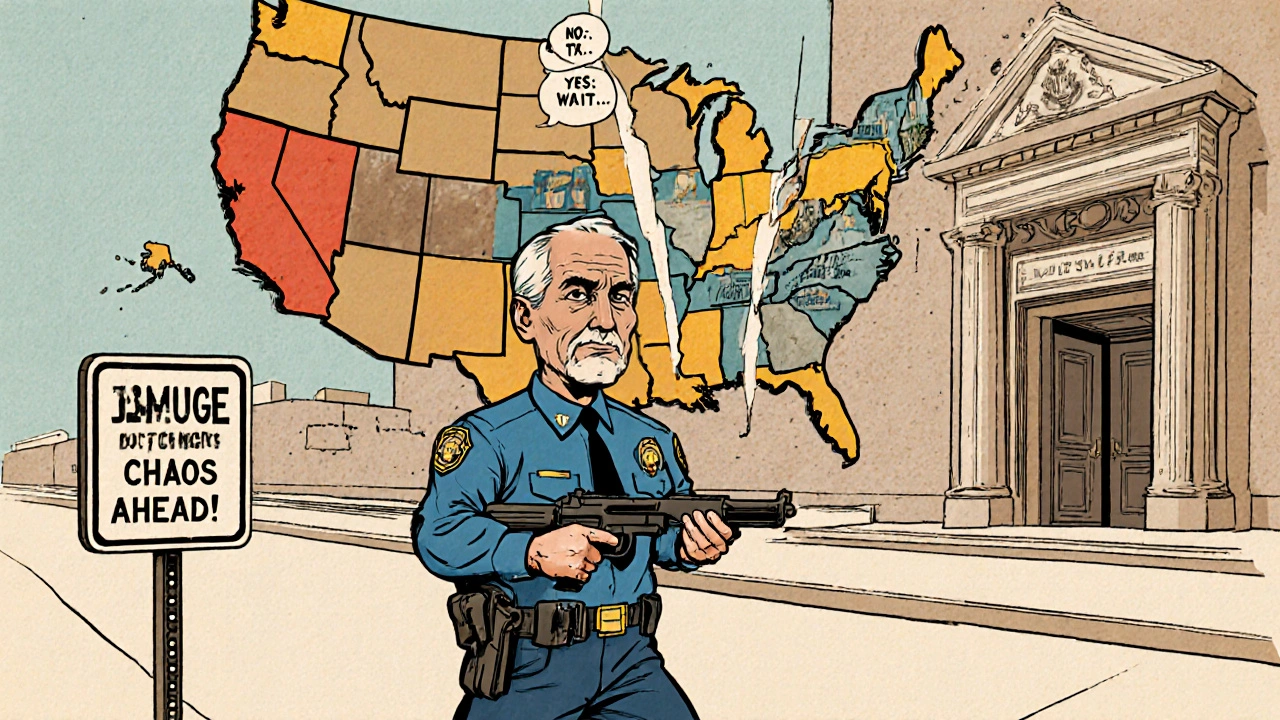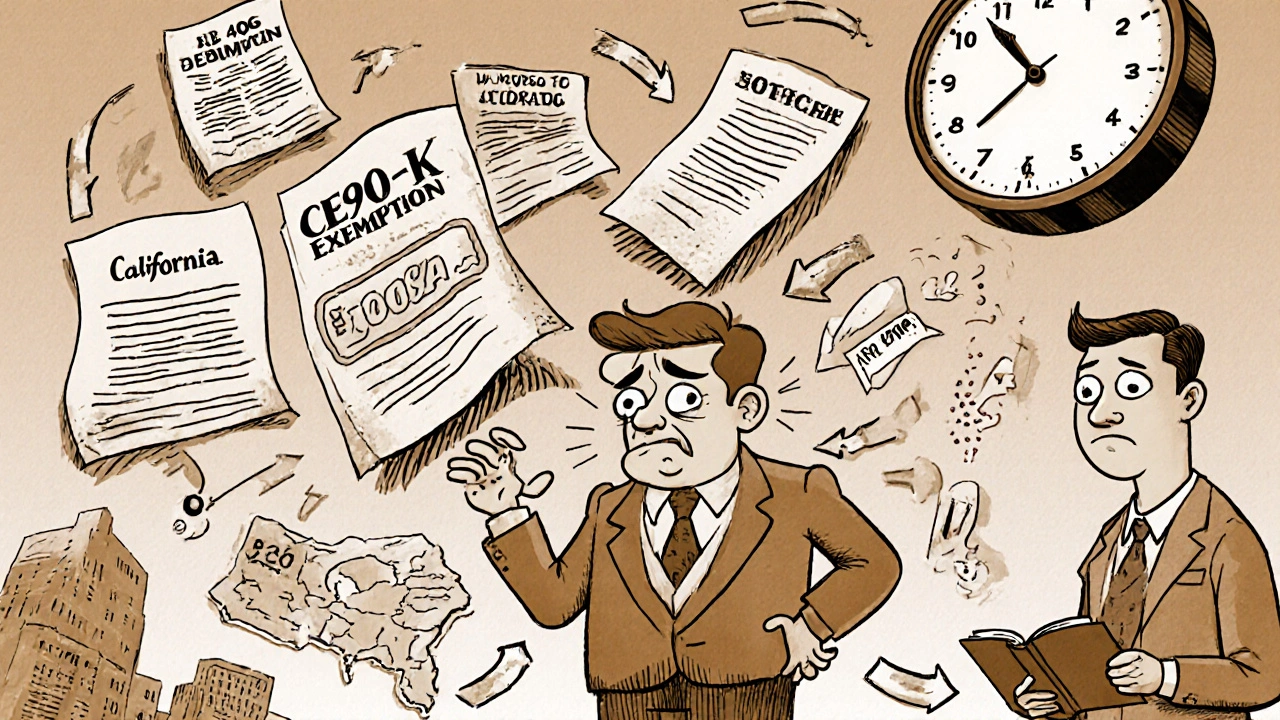By November 2025, the legal landscape in the U.S. has shifted more in the past 18 months than it has in the last decade. It’s not just about new bills being signed-it’s about how those changes ripple through workplaces, tax filings, housing projects, and even how law enforcement carries a gun across state lines. If you’re running a business, managing payroll, or just trying to understand your rights, you can’t afford to ignore what’s happening. The days of waiting for annual compliance updates are over. Regulatory change is now constant, complex, and often contradictory.
Employment Laws Are Overhauling Workplace Rules
California leads the pack with the most aggressive updates. Assembly Bill 406, which took effect on October 1, 2025, didn’t just tweak a rule-it rewrote the playbook on employee leave. It merged two separate leave laws (Labor Code sections 230.2 and 230.5) into the Fair Employment and Housing Act (FEHA), creating one unified rule for victims of violence and their family members. Now, employers must provide up to 10 days of unpaid leave per year, with the option to use paid sick leave instead. The Civil Rights Department released a new model notice, and employers who haven’t updated their handbooks or training materials are already seeing complaints.On top of that, California’s Paid Sick Leave law (Labor Code section 246.5) was rewritten to match the new leave structure. Employers can no longer cap accrual at 48 hours if they use the front-load method. And starting July 1, 2028, Senate Bill 590 will expand Paid Family Leave to cover anyone who’s emotionally close to the person being cared for-not just blood relatives. That means a long-term partner, a close friend who’s been a caregiver for years, or even a chosen family member can now qualify. It’s a cultural shift wrapped in legal language.
These aren’t just California issues. In 2025, 37 out of 50 states passed at least one new employment law, according to the National Conference of State Legislatures. Wage theft protections got stronger in New York and Illinois. The WARN Act got updated in Washington and Oregon to require more notice before mass layoffs. Independent contractor rules tightened in Colorado and New Jersey. If your company has workers in multiple states, you’re now juggling 30+ different versions of the same basic rule.
Tax Changes Are Bigger Than You Think
The "One, Big, Beautiful Bill" (Public Law 119-21), signed on July 4, 2025, didn’t just tweak deductions-it reset expectations for millions of Americans. The most visible change: a $6,000 deduction for taxpayers aged 65 and older, effective for tax years 2025 through 2028. That’s not a credit. It’s a deduction. So if you’re filing as single and making $70,000, you now subtract $6,000 before calculating your tax. For many retirees, that means dropping into a lower bracket-or avoiding the tax altogether.But the real bombshell was the IRS reversing its 2023 decision on Form 1099-K. Starting in 2025, the reporting threshold goes back to $20,000 in gross payments and 200 transactions. That means small Etsy sellers, Uber drivers, and freelance graphic designers who made $15,000 last year won’t get a 1099-K. The IRS issued FS-2025-08 to clarify this, and tax software companies scrambled to update their systems. If you’re a small business owner, this is good news. But if you’re an accountant, it’s a nightmare. You now have to track who got a 1099-K and who didn’t, and explain the difference to clients who thought the $600 rule was permanent.
The Employee Retention Credit (ERC) also got a major overhaul. The bill closed loopholes that allowed businesses to claim credits after they’d already received PPP loans. The IRS released FS-2025-07 to warn taxpayers that improper claims could trigger audits. If your business claimed ERC between 2020 and 2023, you better have documentation. The IRS is already flagging suspicious claims, and penalties are steep.
Housing Laws Are Breaking Old Barriers
California’s housing crisis got a radical solution. Assembly Bill 130 and Senate Bill 131, passed as part of the 2025-2026 state budget, gutted key parts of the California Environmental Quality Act (CEQA). For decades, CEQA allowed any neighbor to delay or block housing projects with lawsuits over noise, traffic, or aesthetics. Now, for qualifying projects-like those near transit hubs, in urban infill zones, or using prefabricated construction-those lawsuits are blocked. The state calls it a "sweeping exemption." The California Building Industry Association says it could cut approval times by 18 to 24 months.This isn’t just about speed. It’s about cost. A typical 100-unit apartment project in Los Angeles used to take 4 years and cost $550,000 per unit. With the new rules, developers estimate they can bring that down to $410,000 per unit. The state’s Department of Finance projects housing production will jump 15% to 20% annually. That’s 50,000 to 70,000 new homes per year in California alone.
But it’s not all smooth sailing. Environmental groups are already preparing lawsuits, arguing the exemptions violate state constitutional protections. Local governments are struggling to adjust their zoning codes. And some cities are trying to create "opt-out" clauses-something the state law doesn’t allow. This is going to play out in court for years.

Firearms and Law Enforcement Rules Are Changing Nationwide
H.R.2243, the LEOSA Reform Act of 2025, passed the House on May 15, 2025, and is now pending in the Senate. If signed, it will let qualified active and retired law enforcement officers carry concealed firearms in places that used to be off-limits: school zones, national parks, state parks, private property open to the public, and even certain federal buildings. The bill also lets states reduce the frequency of firearms qualification tests for retired officers-from once a year to once every three years.This isn’t just about guns. It’s about jurisdictional conflict. Before this, an officer could carry in one state but not the next. Now, they’ll have nationwide authority-unless a state passes its own law to restrict it. States like California and New York are already drafting counter-legislation. Legal experts say this could lead to a patchwork of enforcement, with officers getting arrested in some cities and celebrated in others.
The Supreme Court Is Rewriting the Rules of Power
The Roberts Court turns 20 in 2025. And it’s not just celebrating-it’s reshaping American law. The 2025-2026 term is expected to deliver landmark rulings on presidential power, administrative agencies, and individual rights. The Court has already agreed to hear cases on whether the president can fire agency heads without cause, and whether federal agencies can enforce rules without explicit congressional approval.Legal departments at Fortune 500 companies have already increased constitutional law expertise by 25%, according to Bloomberg Law. Why? Because if the Court rules that agencies like the EPA or SEC can’t enforce rules without Congress saying so, hundreds of regulations could vanish overnight. That’s not speculation-it’s legal strategy. Companies are preparing for deregulation in areas like environmental reporting, financial disclosures, and workplace safety.
But here’s the catch: while federal rules may shrink, state rules are growing. California’s labor laws, New York’s data privacy rules, and Washington’s wage transparency laws are all expanding. So even if the federal government steps back, you’re still bound by state laws. Compliance isn’t getting easier-it’s just getting more complicated.

How to Survive the Regulatory Storm
You can’t stop the changes. But you can stop being caught off guard. Here’s what actually works:- Build a compliance dashboard. Use RegTech tools that track state and federal laws in real time. Gartner says 35% of RegTech companies saw growth in 2025. Deloitte found 78% of Fortune 500 firms plan to use AI-powered monitoring by 2026.
- Train your HR and finance teams quarterly. California employers spent $1,200-$1,800 per employee on AB 406 training. That’s not a cost-it’s insurance.
- Don’t assume federal = simple. Removing a federal rule doesn’t mean you’re free. You still have to update your policies, delete outdated procedures, and train staff on what’s gone. RegEd says 62% of companies that deregulated didn’t update their internal controls-and got fined anyway.
- Know your jurisdiction. If you have employees in 10 states, you have 10 different sets of rules. Use a compliance matrix. Don’t guess.
The future of legal compliance isn’t about checking boxes. It’s about building systems that adapt. The companies that survive 2026 won’t be the ones with the biggest legal teams. They’ll be the ones with the most agile processes.
What’s Coming in 2026
The IRS will release tax inflation adjustments for 2026, including updates tied to the "One, Big, Beautiful Bill." Expect changes to standard deductions, retirement contribution limits, and estate tax thresholds.At least 1,200 new state regulations are expected by December 2025, based on current legislative calendars. Look for new laws on AI hiring tools, remote work taxes, and digital privacy for minors.
And don’t forget the pending federal bill to restore free phone calls for detainees. It’s small, but it’s symbolic. The legal system is starting to recognize that access to counsel isn’t a privilege-it’s a right.
Change is accelerating. The question isn’t whether you’ll adapt. It’s whether you’re ready when the next law drops.
Are the new California employment laws only for big companies?
No. California’s employment laws apply to employers with just one employee. AB 406 and the updated Paid Sick Leave law cover all businesses, regardless of size. Even a solo entrepreneur with one part-time worker must comply. The Civil Rights Department doesn’t make exceptions.
Do I need to file a 1099-K if I made $18,000 in 2025?
No. Starting in 2025, the IRS only requires platforms like PayPal, Venmo, or Etsy to issue a 1099-K if you made over $20,000 AND had at least 200 transactions. If you made $18,000, you won’t get one. But you’re still required to report that income on your tax return.
Can I still be sued under CEQA if I build a housing project in California?
Only if your project doesn’t qualify for the new exemptions. If you’re building near public transit, using modular construction, or in an urban infill zone, lawsuits are blocked. But if you’re building a luxury gated community in a rural area, CEQA still applies. The law doesn’t eliminate review-it narrows who can challenge it.
What happens if I ignore the new federal sentencing guidelines?
The federal sentencing guidelines don’t apply to businesses-they apply to individuals convicted of federal crimes. If you’re a business owner, you don’t need to worry about them. But if you’re a lawyer, judge, or defendant in a federal case, those guidelines are binding unless a judge decides to depart from them. The changes take effect November 1, 2025.
Is the $6,000 tax deduction automatic for seniors?
No. It’s not automatic. You must claim it on your Form 1040. The IRS didn’t change how you file-you still need to select the correct deduction line. Many seniors miss it because they assume their standard deduction is enough. Tax software will prompt you, but if you’re filing by hand, you need to look for the line labeled "Additional Standard Deduction for Age 65+" and enter $6,000.





